Properties of Cardiac Muscle: Excitability, Conductivity, and Function
VerifiedAdded on 2022/09/16
|7
|1403
|29
Essay
AI Summary
This essay delves into the properties of cardiac muscle, a type of involuntary muscle found in vertebrates, specifically within the myocardium. The essay explores key properties such as excitability, which involves the muscle's ability to depolarize and repolarize in response to electrical stimuli, enabling contraction and relaxation. It also examines automaticity, the capacity of cardiac cells, especially pacemaker cells, to spontaneously generate action potentials. Furthermore, the essay discusses conductivity, facilitated by intercalated discs, which allows for the rapid transmission of electrical impulses throughout the heart. The essay provides a detailed overview of cardiac muscle function, including the excitation-contraction coupling mechanism, highlighting the role of calcium ions in regulating contractility and ensuring the rhythmic pumping of blood through the circulatory system. The essay concludes by summarizing the interplay of these properties in enabling the heart's essential function.
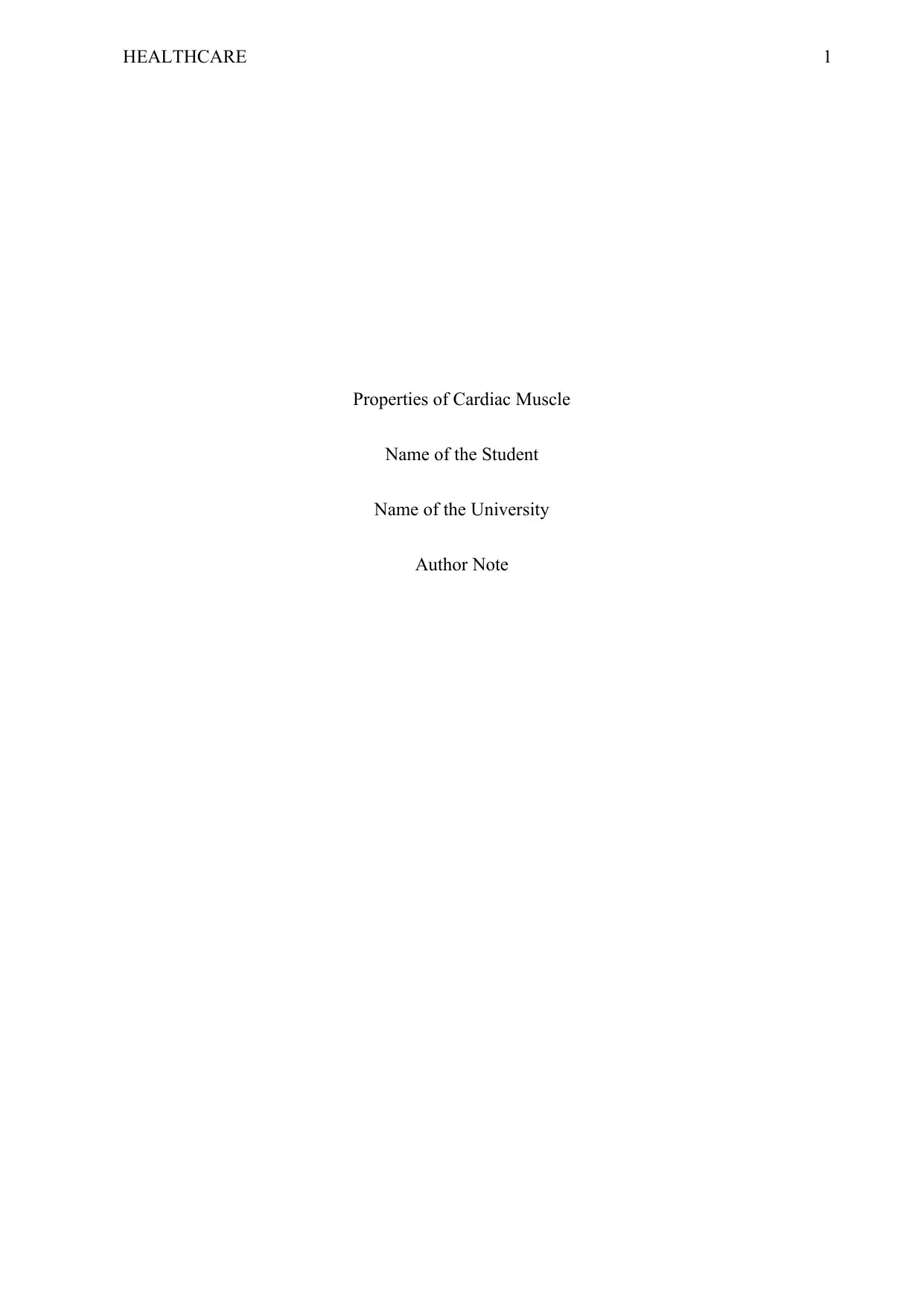
1HEALTHCARE
Properties of Cardiac Muscle
Name of the Student
Name of the University
Author Note
Properties of Cardiac Muscle
Name of the Student
Name of the University
Author Note
Paraphrase This Document
Need a fresh take? Get an instant paraphrase of this document with our AI Paraphraser
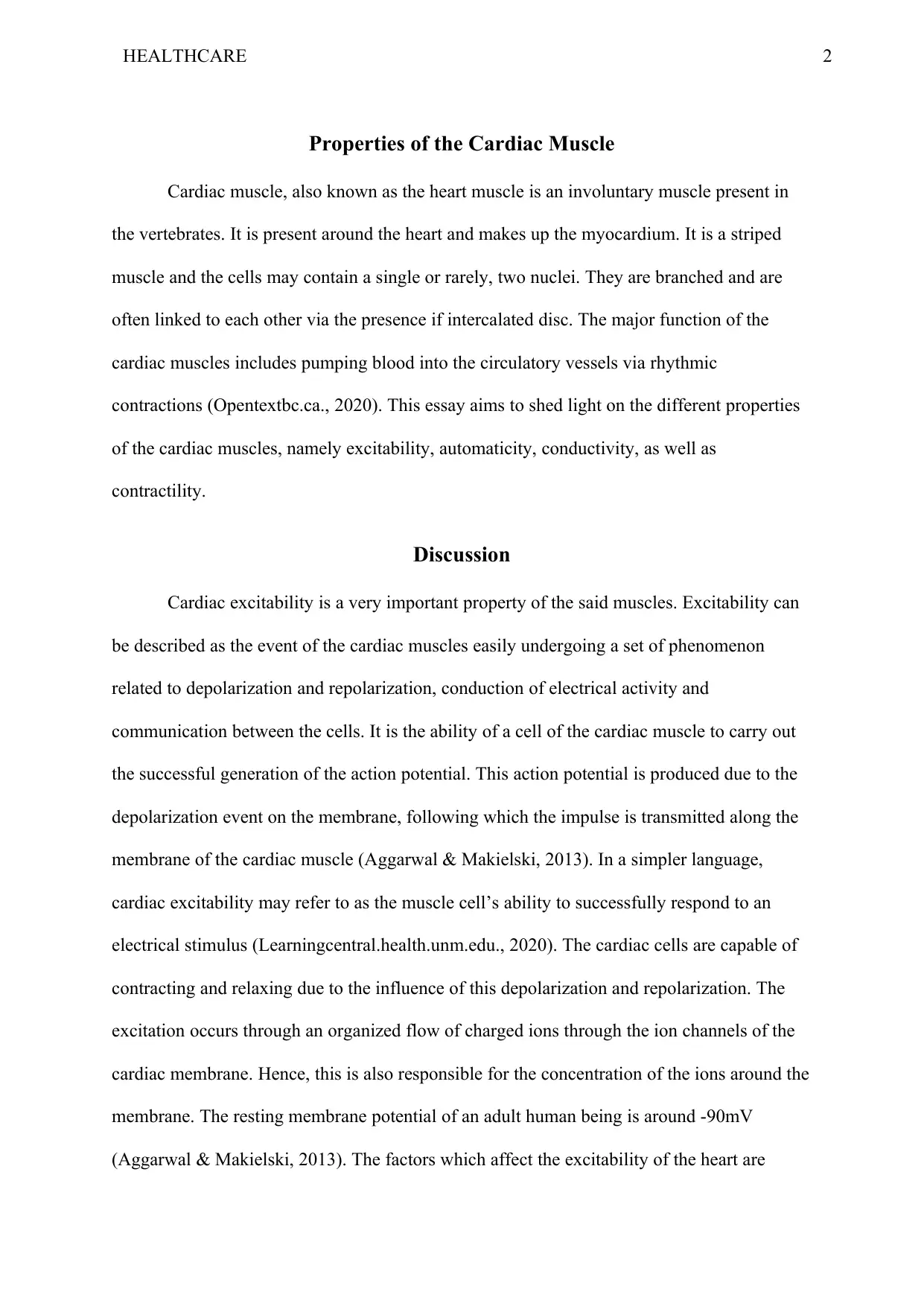
2HEALTHCARE
Properties of the Cardiac Muscle
Cardiac muscle, also known as the heart muscle is an involuntary muscle present in
the vertebrates. It is present around the heart and makes up the myocardium. It is a striped
muscle and the cells may contain a single or rarely, two nuclei. They are branched and are
often linked to each other via the presence if intercalated disc. The major function of the
cardiac muscles includes pumping blood into the circulatory vessels via rhythmic
contractions (Opentextbc.ca., 2020). This essay aims to shed light on the different properties
of the cardiac muscles, namely excitability, automaticity, conductivity, as well as
contractility.
Discussion
Cardiac excitability is a very important property of the said muscles. Excitability can
be described as the event of the cardiac muscles easily undergoing a set of phenomenon
related to depolarization and repolarization, conduction of electrical activity and
communication between the cells. It is the ability of a cell of the cardiac muscle to carry out
the successful generation of the action potential. This action potential is produced due to the
depolarization event on the membrane, following which the impulse is transmitted along the
membrane of the cardiac muscle (Aggarwal & Makielski, 2013). In a simpler language,
cardiac excitability may refer to as the muscle cell’s ability to successfully respond to an
electrical stimulus (Learningcentral.health.unm.edu., 2020). The cardiac cells are capable of
contracting and relaxing due to the influence of this depolarization and repolarization. The
excitation occurs through an organized flow of charged ions through the ion channels of the
cardiac membrane. Hence, this is also responsible for the concentration of the ions around the
membrane. The resting membrane potential of an adult human being is around -90mV
(Aggarwal & Makielski, 2013). The factors which affect the excitability of the heart are
Properties of the Cardiac Muscle
Cardiac muscle, also known as the heart muscle is an involuntary muscle present in
the vertebrates. It is present around the heart and makes up the myocardium. It is a striped
muscle and the cells may contain a single or rarely, two nuclei. They are branched and are
often linked to each other via the presence if intercalated disc. The major function of the
cardiac muscles includes pumping blood into the circulatory vessels via rhythmic
contractions (Opentextbc.ca., 2020). This essay aims to shed light on the different properties
of the cardiac muscles, namely excitability, automaticity, conductivity, as well as
contractility.
Discussion
Cardiac excitability is a very important property of the said muscles. Excitability can
be described as the event of the cardiac muscles easily undergoing a set of phenomenon
related to depolarization and repolarization, conduction of electrical activity and
communication between the cells. It is the ability of a cell of the cardiac muscle to carry out
the successful generation of the action potential. This action potential is produced due to the
depolarization event on the membrane, following which the impulse is transmitted along the
membrane of the cardiac muscle (Aggarwal & Makielski, 2013). In a simpler language,
cardiac excitability may refer to as the muscle cell’s ability to successfully respond to an
electrical stimulus (Learningcentral.health.unm.edu., 2020). The cardiac cells are capable of
contracting and relaxing due to the influence of this depolarization and repolarization. The
excitation occurs through an organized flow of charged ions through the ion channels of the
cardiac membrane. Hence, this is also responsible for the concentration of the ions around the
membrane. The resting membrane potential of an adult human being is around -90mV
(Aggarwal & Makielski, 2013). The factors which affect the excitability of the heart are
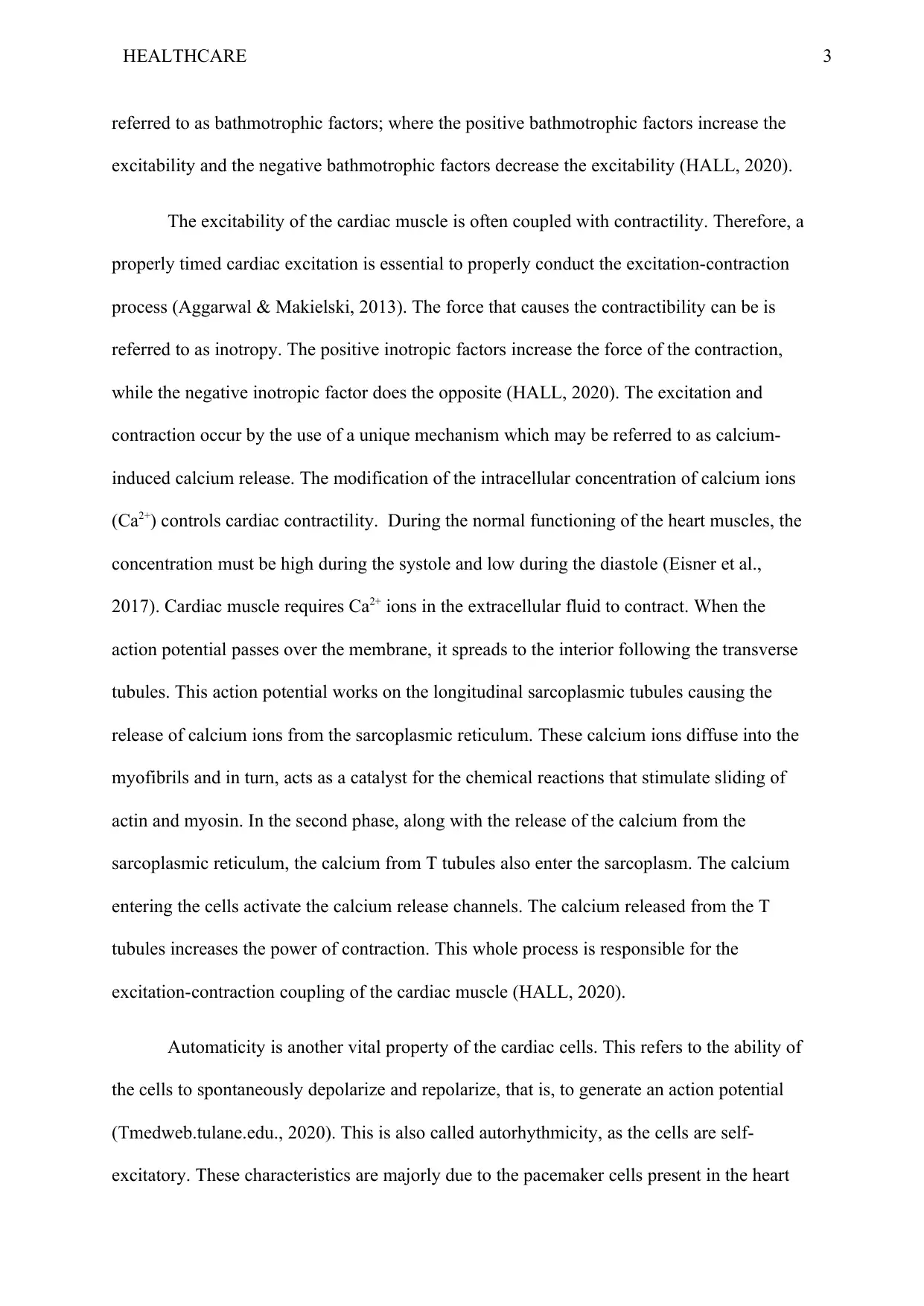
3HEALTHCARE
referred to as bathmotrophic factors; where the positive bathmotrophic factors increase the
excitability and the negative bathmotrophic factors decrease the excitability (HALL, 2020).
The excitability of the cardiac muscle is often coupled with contractility. Therefore, a
properly timed cardiac excitation is essential to properly conduct the excitation-contraction
process (Aggarwal & Makielski, 2013). The force that causes the contractibility can be is
referred to as inotropy. The positive inotropic factors increase the force of the contraction,
while the negative inotropic factor does the opposite (HALL, 2020). The excitation and
contraction occur by the use of a unique mechanism which may be referred to as calcium-
induced calcium release. The modification of the intracellular concentration of calcium ions
(Ca2+) controls cardiac contractility. During the normal functioning of the heart muscles, the
concentration must be high during the systole and low during the diastole (Eisner et al.,
2017). Cardiac muscle requires Ca2+ ions in the extracellular fluid to contract. When the
action potential passes over the membrane, it spreads to the interior following the transverse
tubules. This action potential works on the longitudinal sarcoplasmic tubules causing the
release of calcium ions from the sarcoplasmic reticulum. These calcium ions diffuse into the
myofibrils and in turn, acts as a catalyst for the chemical reactions that stimulate sliding of
actin and myosin. In the second phase, along with the release of the calcium from the
sarcoplasmic reticulum, the calcium from T tubules also enter the sarcoplasm. The calcium
entering the cells activate the calcium release channels. The calcium released from the T
tubules increases the power of contraction. This whole process is responsible for the
excitation-contraction coupling of the cardiac muscle (HALL, 2020).
Automaticity is another vital property of the cardiac cells. This refers to the ability of
the cells to spontaneously depolarize and repolarize, that is, to generate an action potential
(Tmedweb.tulane.edu., 2020). This is also called autorhythmicity, as the cells are self-
excitatory. These characteristics are majorly due to the pacemaker cells present in the heart
referred to as bathmotrophic factors; where the positive bathmotrophic factors increase the
excitability and the negative bathmotrophic factors decrease the excitability (HALL, 2020).
The excitability of the cardiac muscle is often coupled with contractility. Therefore, a
properly timed cardiac excitation is essential to properly conduct the excitation-contraction
process (Aggarwal & Makielski, 2013). The force that causes the contractibility can be is
referred to as inotropy. The positive inotropic factors increase the force of the contraction,
while the negative inotropic factor does the opposite (HALL, 2020). The excitation and
contraction occur by the use of a unique mechanism which may be referred to as calcium-
induced calcium release. The modification of the intracellular concentration of calcium ions
(Ca2+) controls cardiac contractility. During the normal functioning of the heart muscles, the
concentration must be high during the systole and low during the diastole (Eisner et al.,
2017). Cardiac muscle requires Ca2+ ions in the extracellular fluid to contract. When the
action potential passes over the membrane, it spreads to the interior following the transverse
tubules. This action potential works on the longitudinal sarcoplasmic tubules causing the
release of calcium ions from the sarcoplasmic reticulum. These calcium ions diffuse into the
myofibrils and in turn, acts as a catalyst for the chemical reactions that stimulate sliding of
actin and myosin. In the second phase, along with the release of the calcium from the
sarcoplasmic reticulum, the calcium from T tubules also enter the sarcoplasm. The calcium
entering the cells activate the calcium release channels. The calcium released from the T
tubules increases the power of contraction. This whole process is responsible for the
excitation-contraction coupling of the cardiac muscle (HALL, 2020).
Automaticity is another vital property of the cardiac cells. This refers to the ability of
the cells to spontaneously depolarize and repolarize, that is, to generate an action potential
(Tmedweb.tulane.edu., 2020). This is also called autorhythmicity, as the cells are self-
excitatory. These characteristics are majorly due to the pacemaker cells present in the heart
⊘ This is a preview!⊘
Do you want full access?
Subscribe today to unlock all pages.

Trusted by 1+ million students worldwide
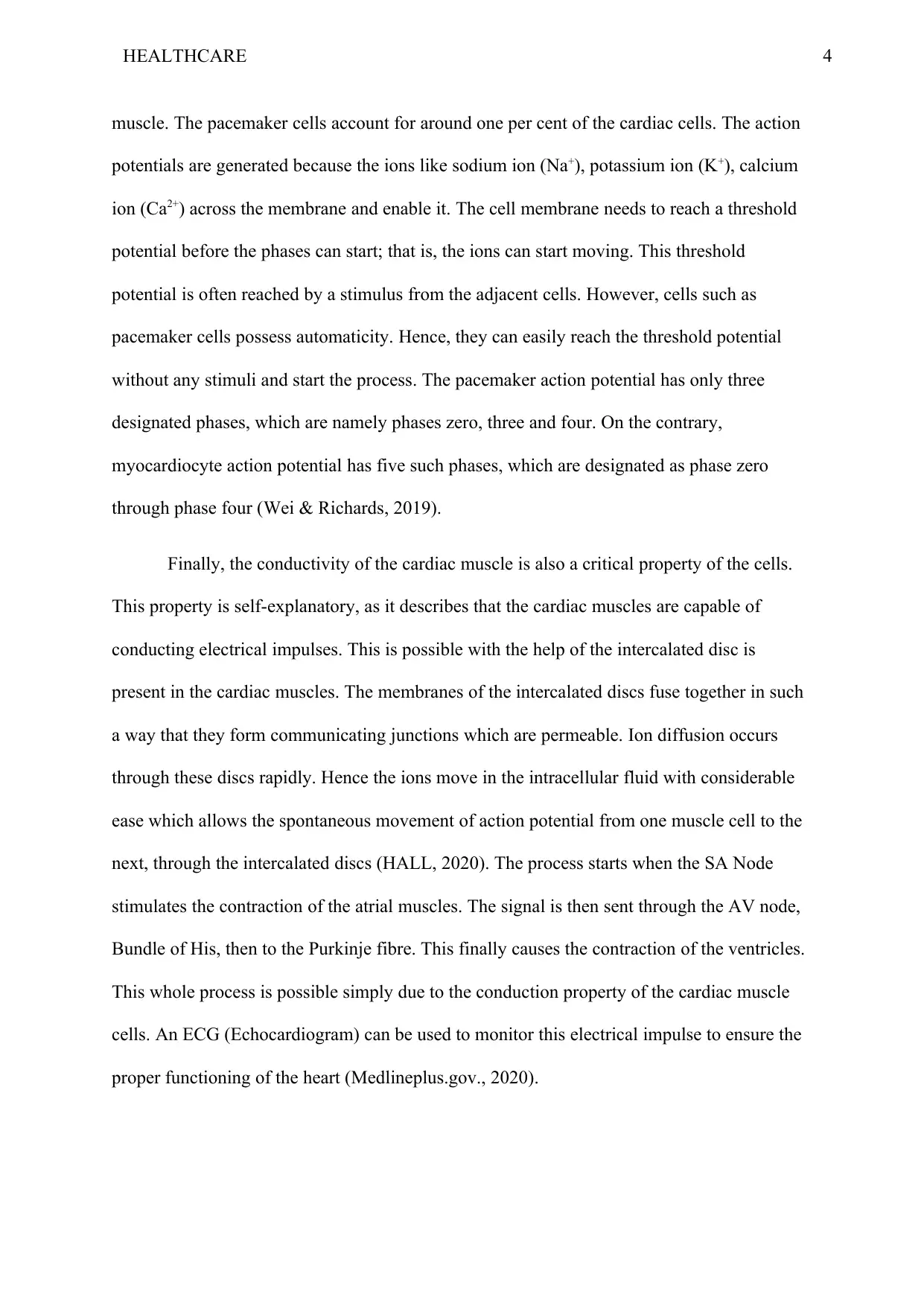
4HEALTHCARE
muscle. The pacemaker cells account for around one per cent of the cardiac cells. The action
potentials are generated because the ions like sodium ion (Na+), potassium ion (K+), calcium
ion (Ca2+) across the membrane and enable it. The cell membrane needs to reach a threshold
potential before the phases can start; that is, the ions can start moving. This threshold
potential is often reached by a stimulus from the adjacent cells. However, cells such as
pacemaker cells possess automaticity. Hence, they can easily reach the threshold potential
without any stimuli and start the process. The pacemaker action potential has only three
designated phases, which are namely phases zero, three and four. On the contrary,
myocardiocyte action potential has five such phases, which are designated as phase zero
through phase four (Wei & Richards, 2019).
Finally, the conductivity of the cardiac muscle is also a critical property of the cells.
This property is self-explanatory, as it describes that the cardiac muscles are capable of
conducting electrical impulses. This is possible with the help of the intercalated disc is
present in the cardiac muscles. The membranes of the intercalated discs fuse together in such
a way that they form communicating junctions which are permeable. Ion diffusion occurs
through these discs rapidly. Hence the ions move in the intracellular fluid with considerable
ease which allows the spontaneous movement of action potential from one muscle cell to the
next, through the intercalated discs (HALL, 2020). The process starts when the SA Node
stimulates the contraction of the atrial muscles. The signal is then sent through the AV node,
Bundle of His, then to the Purkinje fibre. This finally causes the contraction of the ventricles.
This whole process is possible simply due to the conduction property of the cardiac muscle
cells. An ECG (Echocardiogram) can be used to monitor this electrical impulse to ensure the
proper functioning of the heart (Medlineplus.gov., 2020).
muscle. The pacemaker cells account for around one per cent of the cardiac cells. The action
potentials are generated because the ions like sodium ion (Na+), potassium ion (K+), calcium
ion (Ca2+) across the membrane and enable it. The cell membrane needs to reach a threshold
potential before the phases can start; that is, the ions can start moving. This threshold
potential is often reached by a stimulus from the adjacent cells. However, cells such as
pacemaker cells possess automaticity. Hence, they can easily reach the threshold potential
without any stimuli and start the process. The pacemaker action potential has only three
designated phases, which are namely phases zero, three and four. On the contrary,
myocardiocyte action potential has five such phases, which are designated as phase zero
through phase four (Wei & Richards, 2019).
Finally, the conductivity of the cardiac muscle is also a critical property of the cells.
This property is self-explanatory, as it describes that the cardiac muscles are capable of
conducting electrical impulses. This is possible with the help of the intercalated disc is
present in the cardiac muscles. The membranes of the intercalated discs fuse together in such
a way that they form communicating junctions which are permeable. Ion diffusion occurs
through these discs rapidly. Hence the ions move in the intracellular fluid with considerable
ease which allows the spontaneous movement of action potential from one muscle cell to the
next, through the intercalated discs (HALL, 2020). The process starts when the SA Node
stimulates the contraction of the atrial muscles. The signal is then sent through the AV node,
Bundle of His, then to the Purkinje fibre. This finally causes the contraction of the ventricles.
This whole process is possible simply due to the conduction property of the cardiac muscle
cells. An ECG (Echocardiogram) can be used to monitor this electrical impulse to ensure the
proper functioning of the heart (Medlineplus.gov., 2020).
Paraphrase This Document
Need a fresh take? Get an instant paraphrase of this document with our AI Paraphraser
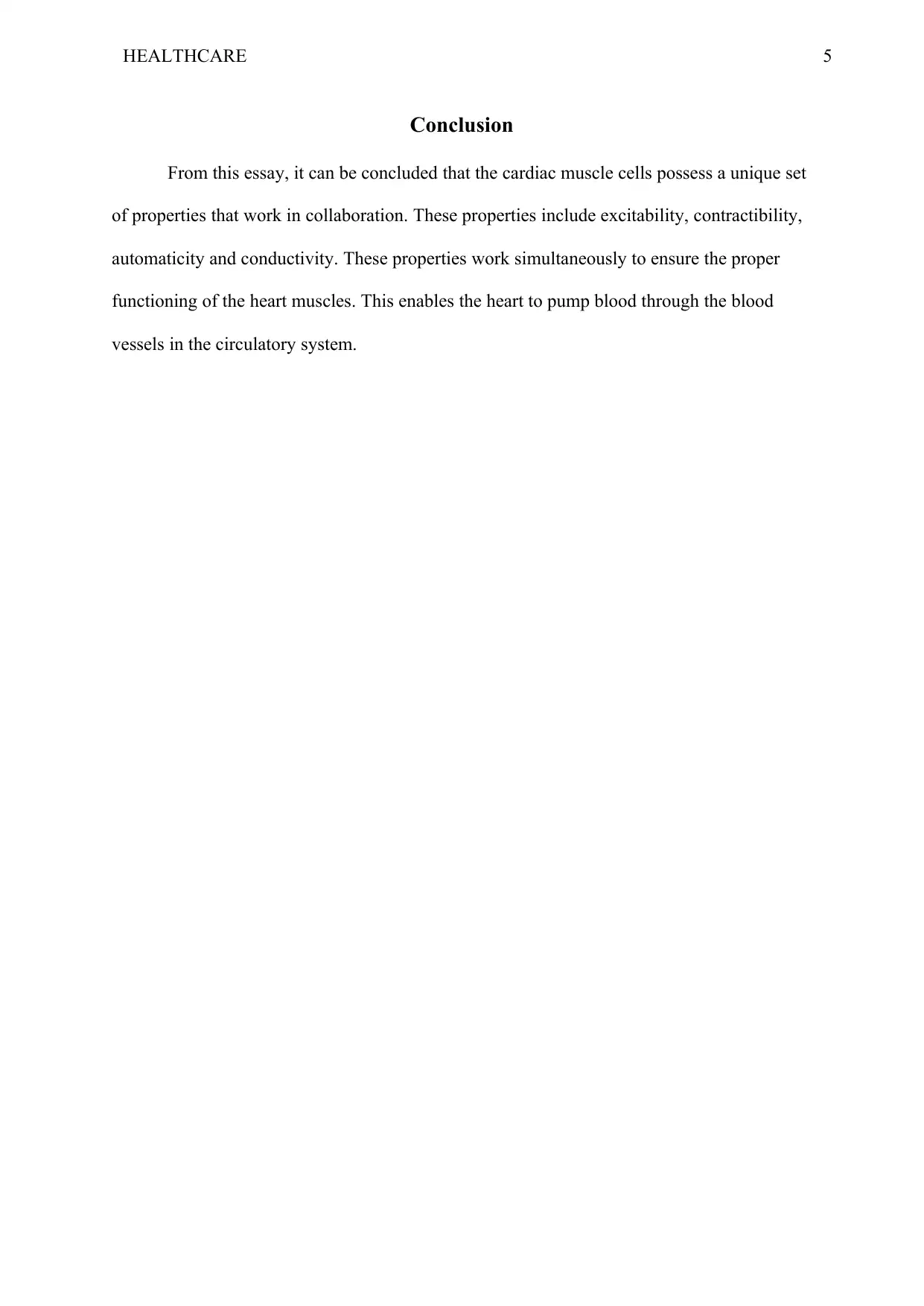
5HEALTHCARE
Conclusion
From this essay, it can be concluded that the cardiac muscle cells possess a unique set
of properties that work in collaboration. These properties include excitability, contractibility,
automaticity and conductivity. These properties work simultaneously to ensure the proper
functioning of the heart muscles. This enables the heart to pump blood through the blood
vessels in the circulatory system.
Conclusion
From this essay, it can be concluded that the cardiac muscle cells possess a unique set
of properties that work in collaboration. These properties include excitability, contractibility,
automaticity and conductivity. These properties work simultaneously to ensure the proper
functioning of the heart muscles. This enables the heart to pump blood through the blood
vessels in the circulatory system.
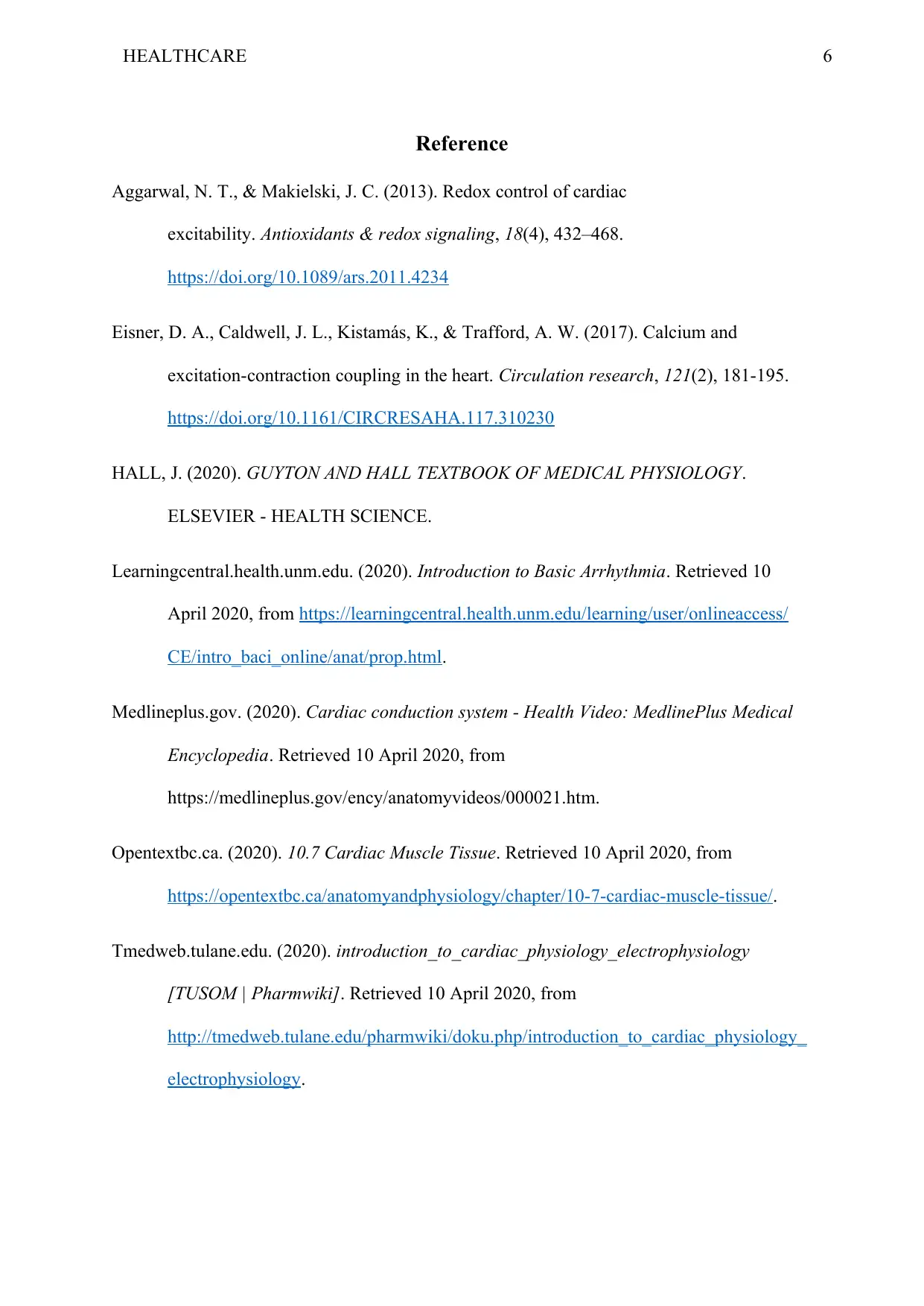
6HEALTHCARE
Reference
Aggarwal, N. T., & Makielski, J. C. (2013). Redox control of cardiac
excitability. Antioxidants & redox signaling, 18(4), 432–468.
https://doi.org/10.1089/ars.2011.4234
Eisner, D. A., Caldwell, J. L., Kistamás, K., & Trafford, A. W. (2017). Calcium and
excitation-contraction coupling in the heart. Circulation research, 121(2), 181-195.
https://doi.org/10.1161/CIRCRESAHA.117.310230
HALL, J. (2020). GUYTON AND HALL TEXTBOOK OF MEDICAL PHYSIOLOGY.
ELSEVIER - HEALTH SCIENCE.
Learningcentral.health.unm.edu. (2020). Introduction to Basic Arrhythmia. Retrieved 10
April 2020, from https://learningcentral.health.unm.edu/learning/user/onlineaccess/
CE/intro_baci_online/anat/prop.html.
Medlineplus.gov. (2020). Cardiac conduction system - Health Video: MedlinePlus Medical
Encyclopedia. Retrieved 10 April 2020, from
https://medlineplus.gov/ency/anatomyvideos/000021.htm.
Opentextbc.ca. (2020). 10.7 Cardiac Muscle Tissue. Retrieved 10 April 2020, from
https://opentextbc.ca/anatomyandphysiology/chapter/10-7-cardiac-muscle-tissue/.
Tmedweb.tulane.edu. (2020). introduction_to_cardiac_physiology_electrophysiology
[TUSOM | Pharmwiki]. Retrieved 10 April 2020, from
http://tmedweb.tulane.edu/pharmwiki/doku.php/introduction_to_cardiac_physiology_
electrophysiology.
Reference
Aggarwal, N. T., & Makielski, J. C. (2013). Redox control of cardiac
excitability. Antioxidants & redox signaling, 18(4), 432–468.
https://doi.org/10.1089/ars.2011.4234
Eisner, D. A., Caldwell, J. L., Kistamás, K., & Trafford, A. W. (2017). Calcium and
excitation-contraction coupling in the heart. Circulation research, 121(2), 181-195.
https://doi.org/10.1161/CIRCRESAHA.117.310230
HALL, J. (2020). GUYTON AND HALL TEXTBOOK OF MEDICAL PHYSIOLOGY.
ELSEVIER - HEALTH SCIENCE.
Learningcentral.health.unm.edu. (2020). Introduction to Basic Arrhythmia. Retrieved 10
April 2020, from https://learningcentral.health.unm.edu/learning/user/onlineaccess/
CE/intro_baci_online/anat/prop.html.
Medlineplus.gov. (2020). Cardiac conduction system - Health Video: MedlinePlus Medical
Encyclopedia. Retrieved 10 April 2020, from
https://medlineplus.gov/ency/anatomyvideos/000021.htm.
Opentextbc.ca. (2020). 10.7 Cardiac Muscle Tissue. Retrieved 10 April 2020, from
https://opentextbc.ca/anatomyandphysiology/chapter/10-7-cardiac-muscle-tissue/.
Tmedweb.tulane.edu. (2020). introduction_to_cardiac_physiology_electrophysiology
[TUSOM | Pharmwiki]. Retrieved 10 April 2020, from
http://tmedweb.tulane.edu/pharmwiki/doku.php/introduction_to_cardiac_physiology_
electrophysiology.
⊘ This is a preview!⊘
Do you want full access?
Subscribe today to unlock all pages.

Trusted by 1+ million students worldwide
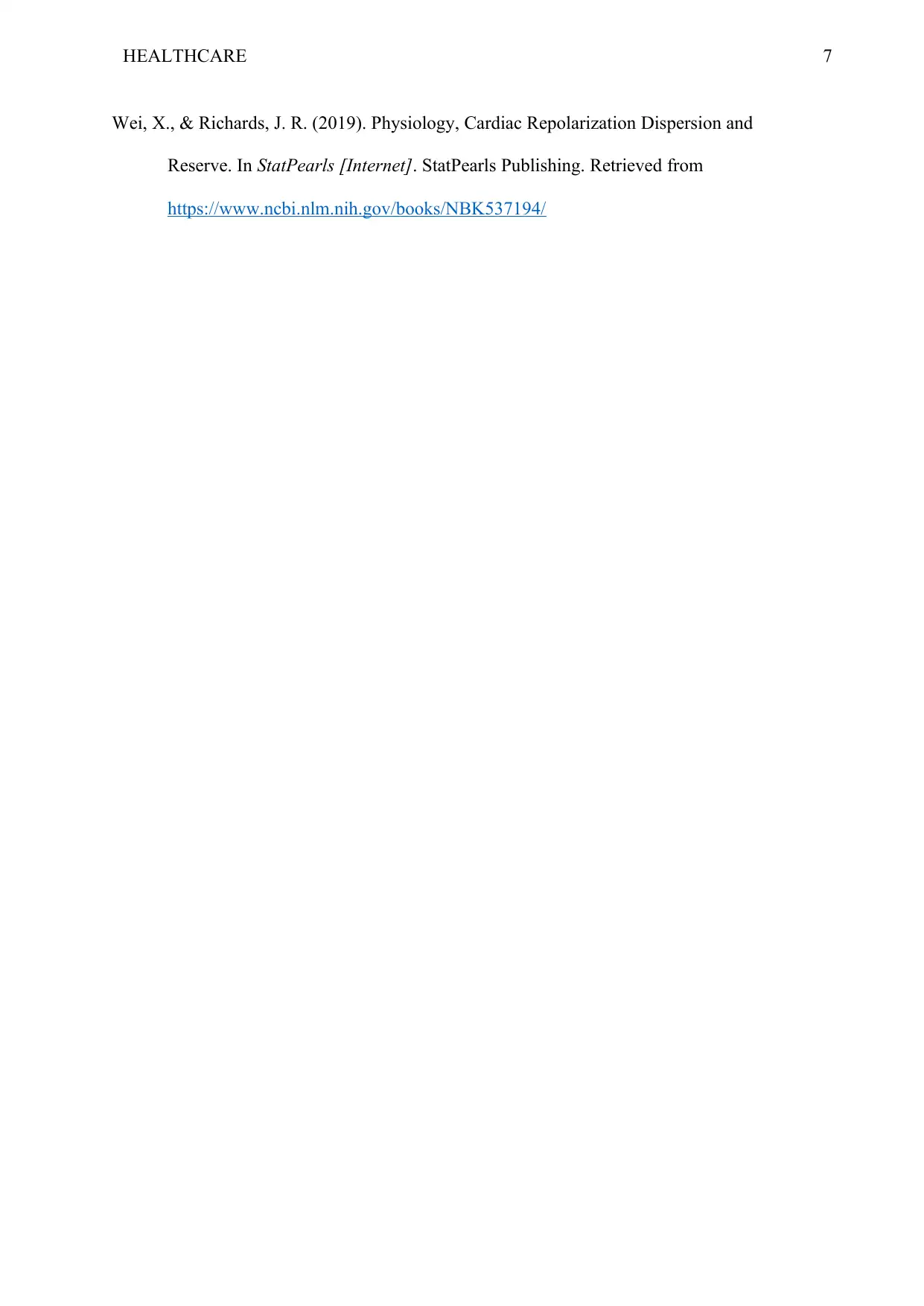
7HEALTHCARE
Wei, X., & Richards, J. R. (2019). Physiology, Cardiac Repolarization Dispersion and
Reserve. In StatPearls [Internet]. StatPearls Publishing. Retrieved from
https://www.ncbi.nlm.nih.gov/books/NBK537194/
Wei, X., & Richards, J. R. (2019). Physiology, Cardiac Repolarization Dispersion and
Reserve. In StatPearls [Internet]. StatPearls Publishing. Retrieved from
https://www.ncbi.nlm.nih.gov/books/NBK537194/
1 out of 7
Related Documents
Your All-in-One AI-Powered Toolkit for Academic Success.
+13062052269
info@desklib.com
Available 24*7 on WhatsApp / Email
![[object Object]](/_next/static/media/star-bottom.7253800d.svg)
Unlock your academic potential
Copyright © 2020–2025 A2Z Services. All Rights Reserved. Developed and managed by ZUCOL.





